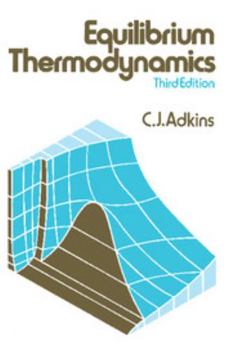Equilibrium Thermodynamics
Select Format
Select Condition 
Book Overview
Equilibrium Thermodynamics gives a comprehensive but concise course in the fundamentals of classical thermodynamics. Although the subject is essentially classical in nature, illustrative material is drawn widely from modern physics and free use is made of microscopic ideas to illuminate it. The overriding objective in writing the book was to achieve a clear exposition: to give an account of the subject that it both stimulating and easy to learn from. Classical thermodynamics has such wide application that it can be taught in many ways. The terms of reference for Equilibrium Thermodynamics are primarily those of the undergraduate physicist; but it is also suitable for courses in chemistry, engineering, materials science etc. The subject is usually taught in the first or second year of an undergraduate course, but the book takes the student to degree standard (and beyond). Prerequisites are elementary or school-level thermal physics.
Format:Paperback
Language:English
ISBN:0521274567
ISBN13:9780521274562
Release Date:January 1984
Publisher:Cambridge University Press
Length:300 Pages
Weight:1.02 lbs.
Dimensions:0.8" x 6.1" x 9.1"
Customer Reviews
4 ratings
Best classical thermodynamics text
Published by Thriftbooks.com User , 15 years ago
After many arduous sessions with other thermodynamics texts, I finally found a clear and intuitive explanation of the fundamentals in this text. I have been referring to this text as necessary for many years. -- Daniel Matuszak, NovoCatalysis
very good
Published by Thriftbooks.com User , 17 years ago
This item arrived within a reasonable amount of time and in very good condition. I am pleased and satisfied.
Concise and accurate
Published by Thriftbooks.com User , 21 years ago
A good, solid introduction. this book is "particularly recommended" on the University of Cambridge Physics dept. course website, so it must be good!
Classical thermo, with clarity & rigor, for physicists
Published by Thriftbooks.com User , 21 years ago
This is a beautifully clear into to thermo, treated purely as macroscopic phenomenology. Equilibrium thermodynamics (or thermostatics, as some call it) has manifold applications-in physics, chemistry, biology, geology, engineering, etc. The author is a physicist, and selects his material accordingly. However, he does devote the penultimate chapter , ch.11 ("Systems of Several Components") to some chemistry-type applications including chemical reactions in ideal gases. Prior to Adkins, most thermo books I studied merged thermo with statistical mechanics. Entropy treated the purely macroscopic or "thermo way" appeared to me abstract & unintuitive, and cycles with heat engines seemed an awkward import from engineering.The author entirely avoids leaning on statistical mechanics for the main thrust of his arguments, but makes a few side remarks about stat mech on occasion. By keeping the thermo pure, he teaches the reader its power and beauty. Everyone should learn thermo this way, and Adkins is a superb guide for the mature physicist. He achieves the unusual feat of providing careful, rigorous arguments while keeping the narrative smoothly flowing and readable. In other words, he honors the intellectual integrity so essential in this discipline, but never stifles the reader with pedantry or excessive detail. The problems are sometimes challenging, but with sustained effort, I could "crack" most of those I tried. It was only in chap. 11 that I started to find the problems too difficult, and that may well reflect my own lack of prior exposure in this area.(By the way, Adkins derives entropy with heat engines and Carnot cycles, but those who like a less torturous or "gizmo-ridden" route to entropy will be pleased that he also includes Caratheodory's abstract argument.)Bravo to the author for creating this first-rate textbook. I cannot praise it too highly.





